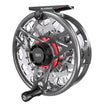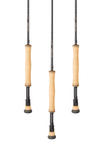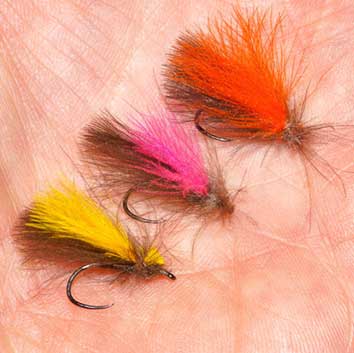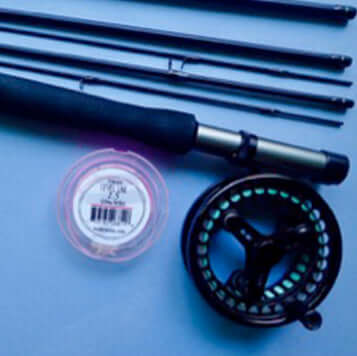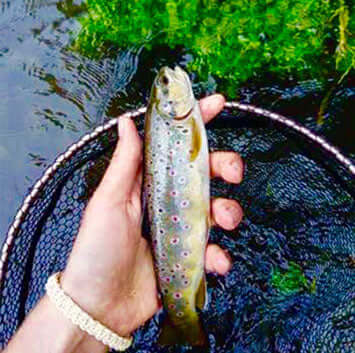I’m a ‘presentation first’ guy believing that presentation is at least nine tenths of the game when it comes to successful fly fishing for trout & grayling. As a result I fish with relatively few fly patterns, all of which are very basic. I try to ascertain what the key triggers are by which the fish recognize my offerings as food & then incorporate them into minimalistic patterns (usually simplified versions of well established patterns devised by others). One of my favourite simple patterns is Marjan Fratnik’s F Fly. I’ve tried a range of variants, all of which have been equally successful.
I am convinced that the main reason for F Fly’s outstanding success is that its triangular/delta-wing profile provides the basic outline of Caddis Flies, Stone Flies, Alder Flies & Moths. As a result I usually no longer bother with a dubbed or roped CdC body for my standard F Fly. All I use is thread & natural Mallard CdC. A measure of its effectiveness is that three short fishing sessions in late summer 2017 on my local Driffield Beck 7 hours fishing produced 37 trout landed plus several others missed or lost. On all three occasions there were very few rising fish but there were a few Black Longhorn Caddis adults fluttering over the water & the fish had seen enough of these to know they were worth eating. All the fish were taken by sight-fishing, mainly to fish that were ‘on the fin’ above mid-water. Very accurate casting & good presentation were essential to success. The slightest drag resulted in rejection of my offering, sometimes after the fish had followed my fly for up to a meter or more downstream. However, if the fish refused a dead drift, a slight twitch or two often prompted an instant response.

Simple (thread & CdC) F Fly

Driffield Beck brown trout that took a Simple F Fly
To ensure a delicate presentation & a drag-free drift I opted for the following setup: a 10’ 4/5 weight progressive actioned rod teamed up with a 3 weight Sunray Jeremy Lucas Micro Thin line with its long delicate front taper down to 0.5mm diameter & a 12’ leader & tippet (7’ cut from the middle of a tapered leader & tapering from 0.45mm down to 0.2mm, plus 5’ of 0.13mm (6x) or 0.15mm (5x) of tippet). I should point out that Jeremy Lucas & Tom Bell recommend just adding tippet but I wanted to extend the delicacy of the system even further. With the underlined rod it works for me thanks to the Italian Style of casting & the Micro Thin line cuts into the wind like a cheese wire, which is fortunate because on two of the days I was fishing into a very brisk breeze. The other advantage of the Italian Style of casting is that the fly is aimed at the water (not above it as with conventional casting) so the wind has much less chance of pushing the fly off-target: this is another reason for the longer than recommended leader setup as it is important that the energy of the cast is fully dissipated by the time the fly lands so that it lands relatively gently.
I do occasionally use two other F Fly variants. The first is Stuart Crofts’ F Ant tied on a size 16 or 18 Grub hook & which has a black thread body coated with UV resin with a red holographic tinsel waist. This variant works well when the fish are taking flying Ants, a food source that can result in preoccupied feeding. The submerged body represents the drowning insect & furthermore it helps to resist micro-drag, acting as an anchor below the surface film.

Stuart Crofts’ F Ant
The second variant, used when fishing turbulent water such as the high alpine streams of Austria, is tied with a roped CdC body, a natural Mallard CdC wing (usually with a dyed CdC overwing for visibility) & often with a collar/legs of CdC fibers in split thread to aid buoyancy.

Hi-viz Fast Water F Fly
With all my CdC dry flies I use Roman Moser Miracle Float, a brilliant floatant recommended to me by Stuart Wardle & available from him at the Durham Fly Fishing Company. When my fly has become drowned & covered with fish slime I use the following procedure to rejuvenate it:
- Rinse the slimed up fly thoroughly in the river/lake.
- Dry thoroughly with kitchen tissue. (I don’t use amadou because if there is any hydrophilic/water-loving slime left on the fly it gets onto the amadou and will then foul up subsequent flies. (Dirty kitchen roll can be replaced).
- Fluff up the fibres with a rub and a blow.
- Spread a small drop of Miracle Float between forefinger & thumb, then rub it into the CdC
Follow these instructions & dozens of fish can be caught on the same CdC fly.






